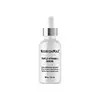What's inside
What's inside
 Key Ingredients
Key Ingredients

 Benefits
Benefits

 Concerns
Concerns

 Ingredients Side-by-side
Ingredients Side-by-side

Water
Skin Conditioning3-O-Ethyl Ascorbic Acid
Skin ConditioningSodium Ascorbyl Phosphate
AntioxidantGlycerin
HumectantButylene Glycol
HumectantPEG-8
HumectantPropanediol
SolventGlycereth-7 Triacetate
EmollientTetrahexyldecyl Ascorbate
AntioxidantPsidium Guajava Leaf Extract
AstringentSaccharomyces Lysate Extract
HumectantNonapeptide-1
Skin ConditioningPsidium Guajava Fruit Extract
AstringentVitis Vinifera Fruit Extract
Skin ConditioningTriticum Vulgare Sprout Extract
Skin ConditioningSodium Hyaluronate
HumectantAloe Barbadensis Leaf Juice
Skin ConditioningCellulose Gum
Emulsion StabilisingXanthan Gum
EmulsifyingTocopheryl Acetate
AntioxidantHydroxymethoxyphenyl Decanone
Skin ConditioningHydroxyethyl Acrylate/Sodium Acryloyldimethyl Taurate Copolymer
Emulsion StabilisingSodium Benzotriazolyl Butylphenol Sulfonate
UV AbsorberCaprylyl Glycol
EmollientDipropylene Glycol
HumectantEthylhexylglycerin
Skin ConditioningParfum
MaskingSodium Phosphate
BufferingDisodium Phosphate
BufferingPhenoxyethanol
PreservativePEG-40 Hydrogenated Castor Oil
EmulsifyingPPG-26-Buteth-26
Skin ConditioningCI 15985
Cosmetic ColorantCI 16035
Cosmetic ColorantWater, 3-O-Ethyl Ascorbic Acid, Sodium Ascorbyl Phosphate, Glycerin, Butylene Glycol, PEG-8, Propanediol, Glycereth-7 Triacetate, Tetrahexyldecyl Ascorbate, Psidium Guajava Leaf Extract, Saccharomyces Lysate Extract, Nonapeptide-1, Psidium Guajava Fruit Extract, Vitis Vinifera Fruit Extract, Triticum Vulgare Sprout Extract, Sodium Hyaluronate, Aloe Barbadensis Leaf Juice, Cellulose Gum, Xanthan Gum, Tocopheryl Acetate, Hydroxymethoxyphenyl Decanone, Hydroxyethyl Acrylate/Sodium Acryloyldimethyl Taurate Copolymer, Sodium Benzotriazolyl Butylphenol Sulfonate, Caprylyl Glycol, Dipropylene Glycol, Ethylhexylglycerin, Parfum, Sodium Phosphate, Disodium Phosphate, Phenoxyethanol, PEG-40 Hydrogenated Castor Oil, PPG-26-Buteth-26, CI 15985, CI 16035
 Reviews
Reviews

Ingredients Explained
These ingredients are found in both products.
Ingredients higher up in an ingredient list are typically present in a larger amount.
Glycerin is already naturally found in your skin. It helps moisturize and protect your skin.
A study from 2016 found glycerin to be more effective as a humectant than AHAs and hyaluronic acid.
As a humectant, it helps the skin stay hydrated by pulling moisture to your skin. The low molecular weight of glycerin allows it to pull moisture into the deeper layers of your skin.
Hydrated skin improves your skin barrier; Your skin barrier helps protect against irritants and bacteria.
Glycerin has also been found to have antimicrobial and antiviral properties. Due to these properties, glycerin is often used in wound and burn treatments.
In cosmetics, glycerin is usually derived from plants such as soybean or palm. However, it can also be sourced from animals, such as tallow or animal fat.
This ingredient is organic, colorless, odorless, and non-toxic.
Glycerin is the name for this ingredient in American English. British English uses Glycerol/Glycerine.
Learn more about GlycerinPhenoxyethanol is a preservative that has germicide, antimicrobial, and aromatic properties. Studies show that phenoxyethanol can prevent microbial growth. By itself, it has a scent that is similar to that of a rose.
It's often used in formulations along with Caprylyl Glycol to preserve the shelf life of products.
Sodium Hyaluronate is hyaluronic acid's salt form. It is commonly derived from the sodium salt of hyaluronic acid.
Like hyaluronic acid, it is great at holding water and acts as a humectant. This makes it a great skin hydrating ingredient.
Sodium Hyaluronate is naturally occurring in our bodies and is mostly found in eye fluid and joints.
These are some other common types of Hyaluronic Acid:
Learn more about Sodium HyaluronateWater. It's the most common cosmetic ingredient of all. You'll usually see it at the top of ingredient lists, meaning that it makes up the largest part of the product.
So why is it so popular? Water most often acts as a solvent - this means that it helps dissolve other ingredients into the formulation.
You'll also recognize water as that liquid we all need to stay alive. If you see this, drink a glass of water. Stay hydrated!
Learn more about Water